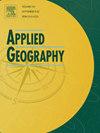高铁建设对碳排放的影响和机制:中国的准自然实验
IF 4
2区 地球科学
Q1 GEOGRAPHY
引用次数: 0
摘要
碳排放是中国面临的一项重大气候挑战。作为碳排放的主要来源,减少与交通相关的碳排放对实现中国的双碳目标至关重要。在此背景下,高速铁路(高铁)作为一种绿色、低碳的替代方案,在减少碳排放方面发挥着越来越重要的作用。本文将高铁建设视为一个准自然实验,利用 2003 年至 2019 年 248 个地级市的数据,探讨了高铁车站建设对碳排放的影响。研究采用空间 DID 模型,探讨了高铁建设如何影响区域内及周边地区的碳排放强度。研究还考虑了社会经济因素,以了解其中介作用。研究结果表明,随着时间的推移,高铁建设能显著减少区域碳排放,其影响具有长期性和逐渐增强的特点。从空间上看,高铁在减少邻近地区碳排放方面也有很大的溢出效应。从数值上看,高铁平均减少了本地区 1.7% 的碳排放,减少了周边地区 2.3% 的碳排放。机理分析表明,高铁的碳减排效益源于多种因素的复杂相互作用,每个选定的因素都发挥了部分中介作用。值得注意的是,人力资本集聚和创新流动是区域碳减排的重要途径。然而,尽管高铁促进了产业结构升级和传统交通的替代,但在当前条件下,这些因素尚未对碳减排做出显著贡献。这些结果凸显了高铁在碳减排中的关键地位,为未来高铁规划和可持续发展政策的制定提供了理论基础。本文章由计算机程序翻译,如有差异,请以英文原文为准。
Impact and mechanisms of high-speed rail construction on carbon emissions: A quasi-natural experiment in China
Carbon emissions present a significant climate challenge for China. As a major source of these emissions, reducing transportation-related carbon output is essential to achieving the country's dual carbon goals. In this context, high-speed rail (HSR) emerges as a green, low-carbon alternative with an increasingly significant role in reducing carbon emissions. This paper explores the impact of HSR station construction on carbon emissions using data from 248 prefecture-level cities from 2003 to 2019, treating the construction as a quasi-natural experiment. Employing a spatial DID model, the research investigates how HSR construction affects carbon emission intensity within the region and in neighboring areas. It also considers socioeconomic factors to understand their mediating roles. The findings reveal that HSR construction significantly reduces regional carbon emissions over time, with long-term and gradually increasing effects. Spatially, HSR also has substantial spillover effects in reducing carbon emissions in adjacent regions. Numerically, HSR reduces carbon emissions by an average of 1.7% in the local region and 2.3% in the surrounding areas. The mechanism analysis indicates that the carbon reduction benefits of HSR stem from a complex interplay of multiple factors, with each selected factor playing a partial mediating role. Notably, the concentration of human capital and the flow of innovation are crucial pathways for regional carbon reduction. However, despite HSR's promotion of industrial structure upgrades and substitution of traditional transportation, these factors have not yet significantly contributed to carbon reduction under current conditions. These results underscore the critical position of HSR in carbon reduction and provide a theoretical foundation for future HSR planning and sustainable development policy formulation.
求助全文
通过发布文献求助,成功后即可免费获取论文全文。
去求助
来源期刊

Applied Geography
GEOGRAPHY-
CiteScore
8.00
自引率
2.00%
发文量
134
期刊介绍:
Applied Geography is a journal devoted to the publication of research which utilizes geographic approaches (human, physical, nature-society and GIScience) to resolve human problems that have a spatial dimension. These problems may be related to the assessment, management and allocation of the world physical and/or human resources. The underlying rationale of the journal is that only through a clear understanding of the relevant societal, physical, and coupled natural-humans systems can we resolve such problems. Papers are invited on any theme involving the application of geographical theory and methodology in the resolution of human problems.
 求助内容:
求助内容: 应助结果提醒方式:
应助结果提醒方式:


